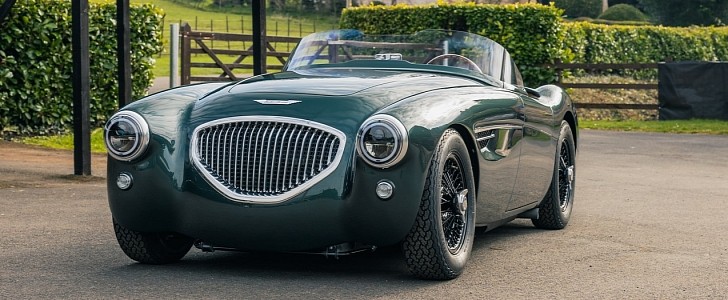One thing that classic car fans seem to detest about EV conversions is that they change how some vehicles were conceived. For the same reason, some of them hate restomod projects: putting new engines under the hood would put the essence of these vehicles in jeopardy. Caton seems to have heard these guys with its first product, the Healey by Caton.
As the name reveals, it is based on an Austin-Healey. More specifically, on the Austin-Healey 100 BN1, introduced in 1953. Caton said it would only make 25 units of this restomod. According to Autocar, it will charge £474,000 ($616,627 at the current exchange rate) a pop, including the donor car and taxes.
Caton is a brand created by Envisage Group, an engineering company based in Coventry. Tim Strafford, the company’s CEO, said the idea was to deliver peace of mind to those willing to buy a classic car. With all its components “reconfigured as new,” the Healey by Caton aims to offer the experience of buying a new car made in 1953 without a time machine.
The company’s only concessions to modern times are LED headlights and a five-speed manual gearbox. The latter allowed Caton to redesign the transmission tunnel, making the roadster more comfortable and roomier.
All else was just improvements to what the car already had. Even the rear semi-elliptic leaf spring setup was preserved. Caton's main amelioration was adding a roll bar to it, something it also did with the front suspension.
If you are wondering about what is under the bonnet, it is the same four-cylinder engine that Donald Healey preferred to adopt in the early days. Caton asked J.M.E. to take care of its improvement. Instead of 2.66 liters, the four-pot now displaces 2.95 liters.
J.M.E. did that by stripping the engine down, lightening it, giving it a full steel crankshaft, upgraded bearing shells, high compression pistons, and a race camshaft with roller rockers. The cherry on the top is two H8 carburetors and race side-exit exhaust pipes.
All things added, the four-pot delivers 185 bhp (138 kW) and 195 pound-feet (264 Nm). That’s more than double what the original engine offered: 90 hp (67 kW). The top speed is above 100 mph (161 kph).
In terms of appearance, the Healey by Caton presents a new front grille and lost the bumpers, seams, and beadings. An English Wheel helped the company change some car panels to make it look a bit different. Inside, the car received new gauges and more premium materials.
Although our gallery helps to present the modifications, those in London between April 21 and April 21 may check out the Healey by Caton live at the Salon Privé London. The event will take place at Royal Hospital Chelsea, and it will be the first public display of the car.
Caton is a brand created by Envisage Group, an engineering company based in Coventry. Tim Strafford, the company’s CEO, said the idea was to deliver peace of mind to those willing to buy a classic car. With all its components “reconfigured as new,” the Healey by Caton aims to offer the experience of buying a new car made in 1953 without a time machine.
The company’s only concessions to modern times are LED headlights and a five-speed manual gearbox. The latter allowed Caton to redesign the transmission tunnel, making the roadster more comfortable and roomier.
All else was just improvements to what the car already had. Even the rear semi-elliptic leaf spring setup was preserved. Caton's main amelioration was adding a roll bar to it, something it also did with the front suspension.
If you are wondering about what is under the bonnet, it is the same four-cylinder engine that Donald Healey preferred to adopt in the early days. Caton asked J.M.E. to take care of its improvement. Instead of 2.66 liters, the four-pot now displaces 2.95 liters.
J.M.E. did that by stripping the engine down, lightening it, giving it a full steel crankshaft, upgraded bearing shells, high compression pistons, and a race camshaft with roller rockers. The cherry on the top is two H8 carburetors and race side-exit exhaust pipes.
All things added, the four-pot delivers 185 bhp (138 kW) and 195 pound-feet (264 Nm). That’s more than double what the original engine offered: 90 hp (67 kW). The top speed is above 100 mph (161 kph).
In terms of appearance, the Healey by Caton presents a new front grille and lost the bumpers, seams, and beadings. An English Wheel helped the company change some car panels to make it look a bit different. Inside, the car received new gauges and more premium materials.
Although our gallery helps to present the modifications, those in London between April 21 and April 21 may check out the Healey by Caton live at the Salon Privé London. The event will take place at Royal Hospital Chelsea, and it will be the first public display of the car.




















